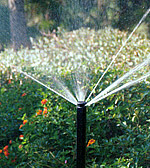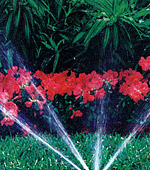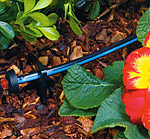Irrigation
Irrigation Water Conservation

- Sensors: Irrigation systems should have sensors to shut down the system when it rains, or when more than enough water has been applied.
- Plants Vs Lawn: Turf and plant beds should be on separate valves. Applying water to both at the same time is one of the biggest wastes of water. Landscapes should be set up in zones, with one valve per zone. Shrubs vs. turf, shade vs. sun, drip vs. standard irrigation should be applied to the configuration and not mixed on the same valve.

- Irrigation Heads: Today's irrigation systems apply water with many different types of heads to accomplish different requirements; Spray heads, Rotary heads, Bubblers, Drip emitters, and Micro Sprays. All of these heads apply water at a different rate. Mixing these different heads on the same valve does not allow an even application of water over the area to be covered.
- Adjust For Seasons: Run times as well as days the system is on should be adjusted throughout the different seasons. A great feature of the newer timeclocks is a seasonal-adjustment option allowing the user to increase or decrease the time allowed by selecting a percentage for adjustment.

- Maintenance: Keep your system in good order; review, adjust, and clean on a regular basis. Take a couple of valves per month and review your irrigation coverage and make the necessary corrections.
- Time of Day: Irrigating at night will reduce water loss..but, depending on the time of the year and type of plant material, be careful not to create an environment for mold and fungus to develop. Early in the morning is usually best. Soil type, microclimate, and plant species need to be considered in determining the time of day to water.

- Maste Valve: On large residential projects or even small projects such as summer homes or where the homeowner is frequently gone, the use of a Master Valve installed at the water source will shut off the water supply when the system is not in use. It will turn the system back on at the next watering cycle. This eliminates the water waste that occurs when no one is home to manually shut down the system.
- Matched Precipitation: Applying an even amount of water at each zone is achieved with matched precipitation rates per zone. A full-circle head should apply four times as much water as a quarter-circle head.

- High - Efficiency Nozzles: As of April 10, 2018 the following irrigation manufacturers have qualified as providing "High - Efficiency Nozzles" by the City of San Diego. Using the nozzles listed is a requirement for qualifying for the City of San Diego Water Rebate Program. (See list of nozzles under "SoCal Water Smart High-Efficiency Nozzles" for a complete list of the qualifying manufacturers.
- Multiple Programs: Today, irrigation timeclocks have multiple programs capable of separating turf areas (usually watered more) from shrub areas. This eliminates wasting water by running all zones at the same time.
- Rainwater: Large storage tanks and collection systems to store rainwater are becoming available to homeowners. Rain barrels to underground storage tanks to storm water retention ponds/waterfalls are available to cover most site situations. With the availability and cost of water on the increase, these retention systems will become more popular in the future.
Areas We Service »
- EXPERT WITNESS SERVING:
State of California, Oregon, Washington, Arizona, Nevada, New Mexico, Florida, New York & Services Available Throughout the U.S. - Carmel Mtn., CA
- Carmel Valley, CA
- Chula Vista, CA
- Clairemont, CA
- Coronado, CA
- Del Mar Highlands, CA
- Del Mar, CA
- La Jolla, CA
- La Mesa, CA
- Mission Hills, CA
- Mt. Helix, CA
- Pacific Beach, CA
- Point Loma, CA
- Poway, CA
- Rancho Penasquitas, CA
- San Diego, CA
- Scripps Ranch, CA
- Solana Beach, CA
- University City, CA
- Encinitas, CA
- Fairbanks Ranch, CA
- Rancho Bernardo, CA
- Rancho Santa Fe, CA
